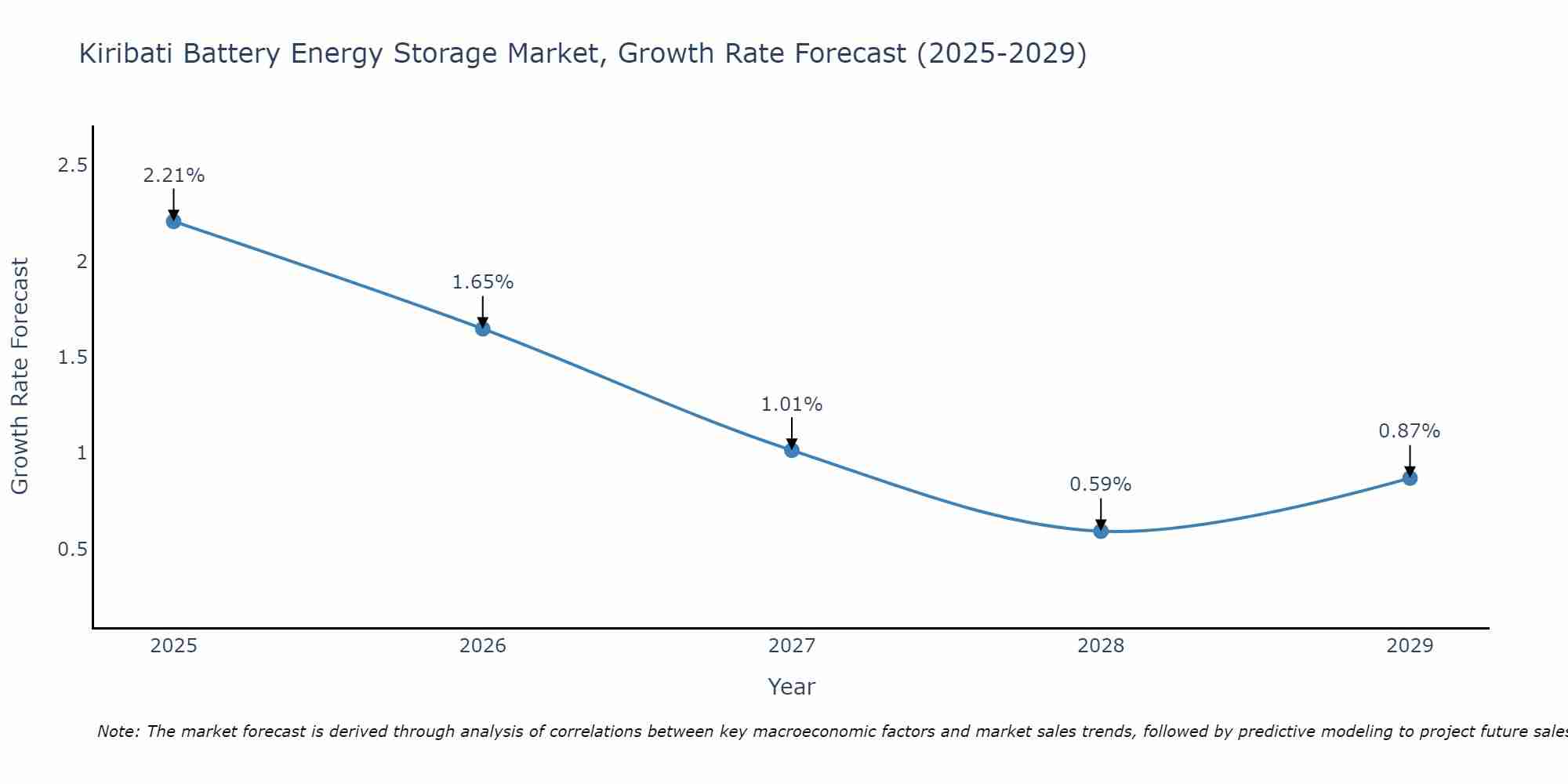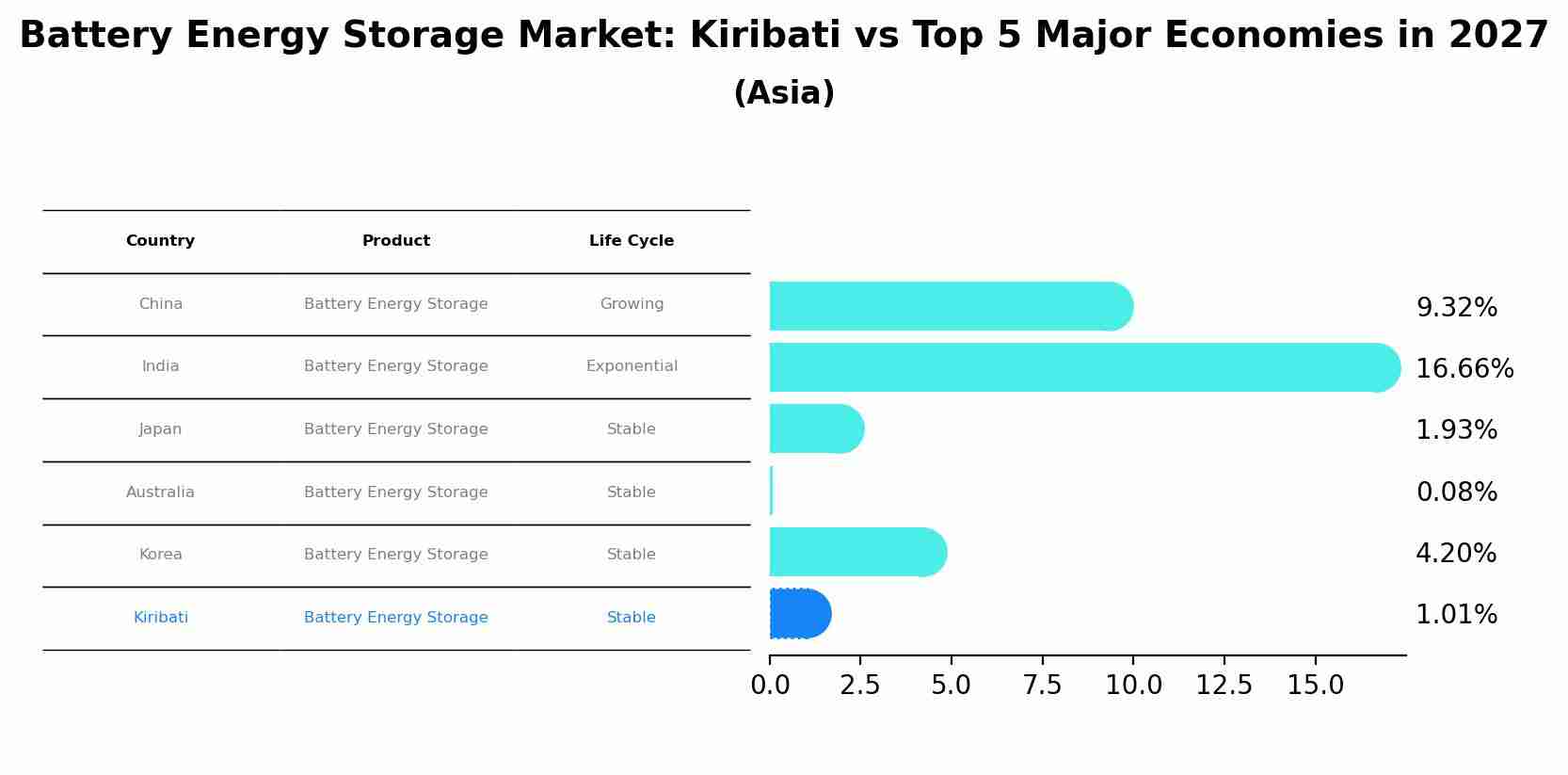Kiribati Battery Energy Storage Market (2025-2031) | Segmentation, Industry, Growth, Share, Companies, Analysis, Outlook, Trends, Forecast, Value, Revenue & Size
| Product Code: ETC5110177 | Publication Date: Nov 2023 | Updated Date: Oct 2025 | Product Type: Market Research Report | |
| Publisher: 6Wresearch | Author: Shubham Padhi | No. of Pages: 60 | No. of Figures: 30 | No. of Tables: 5 |
Kiribati Battery Energy Storage Market Size Growth Rate
The Kiribati Battery Energy Storage Market is projected to witness mixed growth rate patterns during 2025 to 2029. Starting high at 2.21% in 2025, the market steadily declines to 0.87% by 2029.

Battery Energy Storage Market: Kiribati vs Top 5 Major Economies in 2027 (Asia)
The Battery Energy Storage market in Kiribati is projected to grow at a stable growth rate of 1.01% by 2027, within the Asia region led by China, along with other countries like India, Japan, Australia and South Korea, collectively shaping a dynamic and evolving market environment driven by innovation and increasing adoption of emerging technologies.

Key Highlights of the Report:
- Kiribati Battery Energy Storage Market Outlook
- Market Size of Kiribati Battery Energy Storage Market, 2024
- Forecast of Kiribati Battery Energy Storage Market, 2031
- Historical Data and Forecast of Kiribati Battery Energy Storage Revenues & Volume for the Period 2021-2031
- Kiribati Battery Energy Storage Market Trend Evolution
- Kiribati Battery Energy Storage Market Drivers and Challenges
- Kiribati Battery Energy Storage Price Trends
- Kiribati Battery Energy Storage Porter`s Five Forces
- Kiribati Battery Energy Storage Industry Life Cycle
- Historical Data and Forecast of Kiribati Battery Energy Storage Market Revenues & Volume By Type for the Period 2021-2031
- Historical Data and Forecast of Kiribati Battery Energy Storage Market Revenues & Volume By Lithium-ion Battery for the Period 2021-2031
- Historical Data and Forecast of Kiribati Battery Energy Storage Market Revenues & Volume By Lead Acid Battery for the Period 2021-2031
- Historical Data and Forecast of Kiribati Battery Energy Storage Market Revenues & Volume By Flow Battery for the Period 2021-2031
- Historical Data and Forecast of Kiribati Battery Energy Storage Market Revenues & Volume By Others for the Period 2021-2031
- Historical Data and Forecast of Kiribati Battery Energy Storage Market Revenues & Volume By Connectivity for the Period 2021-2031
- Historical Data and Forecast of Kiribati Battery Energy Storage Market Revenues & Volume By Off-Grid for the Period 2021-2031
- Historical Data and Forecast of Kiribati Battery Energy Storage Market Revenues & Volume By On-Grid for the Period 2021-2031
- Historical Data and Forecast of Kiribati Battery Energy Storage Market Revenues & Volume By Application for the Period 2021-2031
- Historical Data and Forecast of Kiribati Battery Energy Storage Market Revenues & Volume By Residential for the Period 2021-2031
- Historical Data and Forecast of Kiribati Battery Energy Storage Market Revenues & Volume By Non-Residential for the Period 2021-2031
- Historical Data and Forecast of Kiribati Battery Energy Storage Market Revenues & Volume By Utility for the Period 2021-2031
- Historical Data and Forecast of Kiribati Battery Energy Storage Market Revenues & Volume By Others for the Period 2021-2031
- Historical Data and Forecast of Kiribati Battery Energy Storage Market Revenues & Volume By Ownership for the Period 2021-2031
- Historical Data and Forecast of Kiribati Battery Energy Storage Market Revenues & Volume By Customer Owned for the Period 2021-2031
- Historical Data and Forecast of Kiribati Battery Energy Storage Market Revenues & Volume By Third-Party Owned for the Period 2021-2031
- Historical Data and Forecast of Kiribati Battery Energy Storage Market Revenues & Volume By Utility Owned for the Period 2021-2031
- Historical Data and Forecast of Kiribati Battery Energy Storage Market Revenues & Volume By Capacity for the Period 2021-2031
- Historical Data and Forecast of Kiribati Battery Energy Storage Market Revenues & Volume By Small Scale (Less than 1 MW) for the Period 2021-2031
- Historical Data and Forecast of Kiribati Battery Energy Storage Market Revenues & Volume By Large Scale (Greater than 1 MW) for the Period 2021-2031
- Kiribati Battery Energy Storage Import Export Trade Statistics
- Market Opportunity Assessment By Type
- Market Opportunity Assessment By Connectivity
- Market Opportunity Assessment By Application
- Market Opportunity Assessment By Ownership
- Market Opportunity Assessment By Capacity
- Kiribati Battery Energy Storage Top Companies Market Share
- Kiribati Battery Energy Storage Competitive Benchmarking By Technical and Operational Parameters
- Kiribati Battery Energy Storage Company Profiles
- Kiribati Battery Energy Storage Key Strategic Recommendations
Frequently Asked Questions About the Market Study (FAQs):
1 Executive Summary |
2 Introduction |
2.1 Key Highlights of the Report |
2.2 Report Description |
2.3 Market Scope & Segmentation |
2.4 Research Methodology |
2.5 Assumptions |
3 Kiribati Battery Energy Storage Market Overview |
3.1 Kiribati Country Macro Economic Indicators |
3.2 Kiribati Battery Energy Storage Market Revenues & Volume, 2021 & 2031F |
3.3 Kiribati Battery Energy Storage Market - Industry Life Cycle |
3.4 Kiribati Battery Energy Storage Market - Porter's Five Forces |
3.5 Kiribati Battery Energy Storage Market Revenues & Volume Share, By Type, 2021 & 2031F |
3.6 Kiribati Battery Energy Storage Market Revenues & Volume Share, By Connectivity, 2021 & 2031F |
3.7 Kiribati Battery Energy Storage Market Revenues & Volume Share, By Application, 2021 & 2031F |
3.8 Kiribati Battery Energy Storage Market Revenues & Volume Share, By Ownership, 2021 & 2031F |
3.9 Kiribati Battery Energy Storage Market Revenues & Volume Share, By Capacity, 2021 & 2031F |
4 Kiribati Battery Energy Storage Market Dynamics |
4.1 Impact Analysis |
4.2 Market Drivers |
4.2.1 Government initiatives and policies promoting renewable energy sources |
4.2.2 Increasing demand for reliable and sustainable energy solutions |
4.2.3 Growth in renewable energy projects and installations in Kiribati |
4.3 Market Restraints |
4.3.1 High initial investment costs associated with battery energy storage systems |
4.3.2 Limited technical expertise and infrastructure for large-scale energy storage projects in Kiribati |
4.3.3 Dependency on imports for battery storage technologies |
5 Kiribati Battery Energy Storage Market Trends |
6 Kiribati Battery Energy Storage Market Segmentations |
6.1 Kiribati Battery Energy Storage Market, By Type |
6.1.1 Overview and Analysis |
6.1.2 Kiribati Battery Energy Storage Market Revenues & Volume, By Lithium-ion Battery, 2021-2031F |
6.1.3 Kiribati Battery Energy Storage Market Revenues & Volume, By Lead Acid Battery, 2021-2031F |
6.1.4 Kiribati Battery Energy Storage Market Revenues & Volume, By Flow Battery, 2021-2031F |
6.1.5 Kiribati Battery Energy Storage Market Revenues & Volume, By Others, 2021-2031F |
6.2 Kiribati Battery Energy Storage Market, By Connectivity |
6.2.1 Overview and Analysis |
6.2.2 Kiribati Battery Energy Storage Market Revenues & Volume, By Off-Grid, 2021-2031F |
6.2.3 Kiribati Battery Energy Storage Market Revenues & Volume, By On-Grid, 2021-2031F |
6.3 Kiribati Battery Energy Storage Market, By Application |
6.3.1 Overview and Analysis |
6.3.2 Kiribati Battery Energy Storage Market Revenues & Volume, By Residential, 2021-2031F |
6.3.3 Kiribati Battery Energy Storage Market Revenues & Volume, By Non-Residential, 2021-2031F |
6.3.4 Kiribati Battery Energy Storage Market Revenues & Volume, By Utility, 2021-2031F |
6.3.5 Kiribati Battery Energy Storage Market Revenues & Volume, By Others, 2021-2031F |
6.4 Kiribati Battery Energy Storage Market, By Ownership |
6.4.1 Overview and Analysis |
6.4.2 Kiribati Battery Energy Storage Market Revenues & Volume, By Customer Owned, 2021-2031F |
6.4.3 Kiribati Battery Energy Storage Market Revenues & Volume, By Third-Party Owned, 2021-2031F |
6.4.4 Kiribati Battery Energy Storage Market Revenues & Volume, By Utility Owned, 2021-2031F |
6.5 Kiribati Battery Energy Storage Market, By Capacity |
6.5.1 Overview and Analysis |
6.5.2 Kiribati Battery Energy Storage Market Revenues & Volume, By Small Scale (Less than 1 MW), 2021-2031F |
6.5.3 Kiribati Battery Energy Storage Market Revenues & Volume, By Large Scale (Greater than 1 MW), 2021-2031F |
7 Kiribati Battery Energy Storage Market Import-Export Trade Statistics |
7.1 Kiribati Battery Energy Storage Market Export to Major Countries |
7.2 Kiribati Battery Energy Storage Market Imports from Major Countries |
8 Kiribati Battery Energy Storage Market Key Performance Indicators |
8.1 Percentage of renewable energy sources in Kiribati's energy mix |
8.2 Investment in renewable energy projects and infrastructure |
8.3 Rate of adoption of battery energy storage systems in Kiribati |
9 Kiribati Battery Energy Storage Market - Opportunity Assessment |
9.1 Kiribati Battery Energy Storage Market Opportunity Assessment, By Type, 2021 & 2031F |
9.2 Kiribati Battery Energy Storage Market Opportunity Assessment, By Connectivity, 2021 & 2031F |
9.3 Kiribati Battery Energy Storage Market Opportunity Assessment, By Application, 2021 & 2031F |
9.4 Kiribati Battery Energy Storage Market Opportunity Assessment, By Ownership, 2021 & 2031F |
9.5 Kiribati Battery Energy Storage Market Opportunity Assessment, By Capacity, 2021 & 2031F |
10 Kiribati Battery Energy Storage Market - Competitive Landscape |
10.1 Kiribati Battery Energy Storage Market Revenue Share, By Companies, 2024 |
10.2 Kiribati Battery Energy Storage Market Competitive Benchmarking, By Operating and Technical Parameters |
11 Company Profiles |
12 Recommendations | 13 Disclaimer |
- Single User License$ 1,995
- Department License$ 2,400
- Site License$ 3,120
- Global License$ 3,795
Search
Thought Leadership and Analyst Meet
Our Clients
Related Reports
- Afghanistan Apparel Market (2026-2032) | Growth, Outlook, Industry, Segmentation, Forecast, Size, Companies, Trends, Value, Share, Analysis & Revenue
- Canada Oil and Gas Market (2026-2032) | Share, Segmentation, Value, Industry, Trends, Forecast, Analysis, Size & Revenue, Growth, Competitive Landscape, Outlook, Companies
- Germany Breakfast Food Market (2026-2032) | Industry, Share, Growth, Size, Companies, Value, Analysis, Revenue, Trends, Forecast & Outlook
- Australia Briquette Market (2025-2031) | Growth, Size, Revenue, Forecast, Analysis, Trends, Value, Share, Industry & Companies
- Vietnam System Integrator Market (2025-2031) | Size, Companies, Analysis, Industry, Value, Forecast, Growth, Trends, Revenue & Share
- ASEAN and Thailand Brain Health Supplements Market (2025-2031) | Strategy, Consumer Insights, Analysis, Investment Trends, Opportunities, Growth, Size, Share, Industry, Revenue, Segments, Value, Segmentation, Supply, Forecast, Restraints, Outlook, Competition, Drivers, Trends, Demand, Pricing Analysis, Competitive, Strategic Insights, Companies, Challenges
- ASEAN Bearings Market (2025-2031) | Strategy, Consumer Insights, Analysis, Investment Trends, Opportunities, Growth, Size, Share, Industry, Revenue, Segments, Value, Segmentation, Supply, Forecast, Restraints, Outlook, Competition, Drivers, Trends, Demand, Pricing Analysis, Competitive, Strategic Insights, Companies, Challenges
- Europe Flooring Market (2025-2031) | Outlook, Share, Industry, Trends, Forecast, Companies, Revenue, Size, Analysis, Growth & Value
- Saudi Arabia Manlift Market (2025-2031) | Outlook, Size, Growth, Trends, Companies, Industry, Revenue, Value, Share, Forecast & Analysis
- Uganda Excavator, Crane, and Wheel Loaders Market (2025-2031) | Strategy, Consumer Insights, Analysis, Investment Trends, Opportunities, Growth, Size, Share, Industry, Revenue, Segments, Value, Segmentation, Supply, Forecast, Restraints, Outlook, Competition, Drivers, Trends, Demand, Pricing Analysis, Competitive, Strategic Insights, Companies, Challenges
Industry Events and Analyst Meet
Whitepaper
- Middle East & Africa Commercial Security Market Click here to view more.
- Middle East & Africa Fire Safety Systems & Equipment Market Click here to view more.
- GCC Drone Market Click here to view more.
- Middle East Lighting Fixture Market Click here to view more.
- GCC Physical & Perimeter Security Market Click here to view more.
6WResearch In News
- Doha a strategic location for EV manufacturing hub: IPA Qatar
- Demand for luxury TVs surging in the GCC, says Samsung
- Empowering Growth: The Thriving Journey of Bangladesh’s Cable Industry
- Demand for luxury TVs surging in the GCC, says Samsung
- Video call with a traditional healer? Once unthinkable, it’s now common in South Africa
- Intelligent Buildings To Smooth GCC’s Path To Net Zero


















